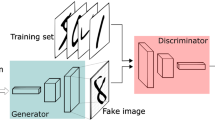Abstract
The latest technological discovery in the field of artificial intelligence (AI) is the learning and widespread use of different Generative Adversarial Networks (GANs) applications. GANs have made progress in numerous applications like image editing, style transfer, scene generation, so on. However, these types of generative models demand high computation because GANs are made out of two deep neural networks and in light of the fact that it trains on huge datasets. As with other AI models, GANs also face problems of insufficient data while training for some real-world situations. In numerous situations, available databases might be restricted and distributed over various worker nodes (i.e., end users) where the local datasets are intrinsically private and ultimately workers toward the end do not want to share them. In this chapter, we addressed the issue of training GANs in a distributed way so that they can train over datasets that are distributed to various worker nodes. We have developed a training framework for GANs under the setting of the parameter server and worker node. Under this framework, various workers can produce results similar to real data while kee** it completely in a distributed way and also kee** their information confidential. Test results obtained with the CIFAR-10 dataset indicate that our architecture can produce high-quality data samples that look similar to real data and can be used in various real-life applications.
Access this chapter
Tax calculation will be finalised at checkout
Purchases are for personal use only
Similar content being viewed by others
References
Goodfellow, Ian, Jean Pouget-Abadie, Mehdi Mirza, Bing Xu, David Warde-Farley, Sherjil Ozair, Aaron Courville, and Yoshua Bengio. “Generative adversarial nets.” In Advances in neural information processing systems, pp. 2672–2680. 2014.
Ranjan, Amit, Debanshu Lalwani, and Rajiv Misra. “GAN for synthesizing CT from T2-weighted MRI data towards MR-guided radiation treatment.” Magnetic Resonance Materials in Physics, Biology and Medicine pp. 1–9. 2021.
Mirza, Mehdi, and Simon Osindero. “Conditional generative adversarial nets.” ar**v preprint ar**v:1411.1784 (2014).
Deb, Sagar Deep, et al. “Facial Expression Classification using Multi-Scale Histogram of Oriented Gradients.” International Journal of Image Processing and Pattern Recognition 6.1 (2020): 5–13.
Ranjan, Amit, et al. “Generating novel molecule for target protein (SARS-CoV-2) using drug–target interaction based on graph neural network.” Network Modeling Analysis in Health Informatics and Bioinformatics 11.1 (2022): 1–11.
Hsieh, Kevin, Aaron Harlap, Nandita Vijaykumar, Dimitris Konomis, Gregory R. Ganger, Phillip B. Gibbons, and Onur Mutlu. “Gaia: Geo-distributed machine learning approaching LAN speeds.” In 14th USENIX Symposium on Networked Systems Design and Implementation (NSDI 17), pp. 629–647. 2017.
Dean, Jeffrey, Greg Corrado, Rajat Monga, Kai Chen, Matthieu Devin, Mark Mao, Marc’aurelio Ranzato et al. “Large scale distributed deep networks.” In Advances in neural information processing systems, pp. 1223–1231. 2012.
Konečný, Jakub, H. Brendan McMahan, Felix X. Yu, Peter Richtárik, Ananda Theertha Suresh, and Dave Bacon. “Federated learning: Strategies for improving communication efficiency.” ar**v preprint ar**v:1610.05492 (2018).
Hoang, Quan, Tu Dinh Nguyen, Trung Le, and Dinh Phung. “Multi-generator generative adversarial nets.” ar**v preprint ar**v:1708.02556 (2017).
Durugkar, Ishan, Ian Gemp, and Sridhar Mahadevan. “Generative multi-adversarial networks.” ar**v preprint ar**v:1611.01673 (2018).
Ranjan, Amit, et al. “Transfer Learning Based Approach for Pneumonia Detection Using Customized VGG16 Deep Learning Model.” International Conference on Internet of Things and Connected Technologies. Springer, Cham, 2021.
Ghosh, Arnab, Viveka Kulharia, Vinay P. Namboodiri, Philip HS Torr, and Puneet K. Dokania. “Multi-agent diverse generative adversarial networks.” In Proceedings of the IEEE conference on computer vision and pattern recognition, pp. 8513–8521. 2018.
Deb, Sagar Deep, et al. “A multi model ensemble based deep convolution neural network structure for detection of COVID19.” Biomedical Signal Processing and Control 71 (2022): 103126.
Yonetani, Ryo, Tomohiro Takahashi, Atsushi Hashimoto, and Yoshitaka Ushiku. “Decentralized Learning of Generative Adversarial Networks from Non-iid Data.” ar**v preprint ar**v:1905.09684 (2019).
Fan, Chenyou, and ** Liu. “Federated Generative Adversarial Learning.” ar**v preprint ar**v:2005.03793 (2020).
A. Krizhevsky, “Learning multiple layers of features from tiny images,” 2009.
Radford, Alec, Luke Metz, and Soumith Chintala. “Unsupervised representation learning with deep convolutional generative adversarial networks.” ar**v preprint ar**v:1511.06434 (2015).
Yang, Chao-Tung, et al. “An energy-efficient cloud system with novel dynamic resource allocation methods.” The Journal of Supercomputing 75.8 (2019): 4408–4429.
Verma, Vinod Kumar, et al. “Next-generation Internet of things and cloud security solutions.” International Journal of Distributed Sensor Networks 15.3 (2019): 1550147719835098.
Author information
Authors and Affiliations
Corresponding author
Editor information
Editors and Affiliations
Rights and permissions
Copyright information
© 2023 The Author(s), under exclusive license to Springer Nature Switzerland AG
About this paper
Cite this paper
Ranjan, A., Misra, R. (2023). Training Generative Adversarial Networks (GANs) Over Parameter Server and Worker Node Architecture. In: Misra, R., Omer, R., Rajarajan, M., Veeravalli, B., Kesswani, N., Mishra, P. (eds) Machine Learning and Big Data Analytics. ICMLBDA 2022. Springer Proceedings in Mathematics & Statistics, vol 401. Springer, Cham. https://doi.org/10.1007/978-3-031-15175-0_33
Download citation
DOI: https://doi.org/10.1007/978-3-031-15175-0_33
Published:
Publisher Name: Springer, Cham
Print ISBN: 978-3-031-15174-3
Online ISBN: 978-3-031-15175-0
eBook Packages: Mathematics and StatisticsMathematics and Statistics (R0)




